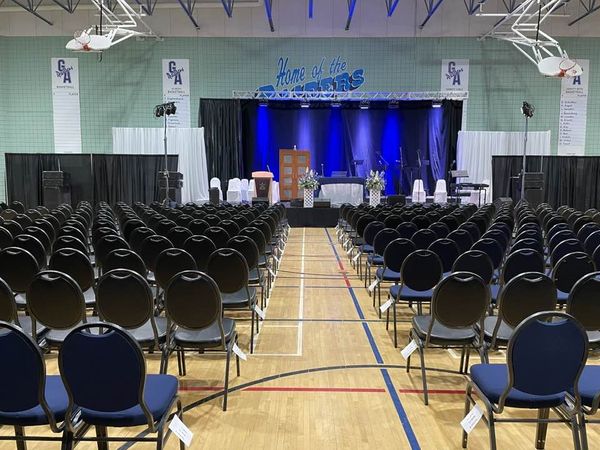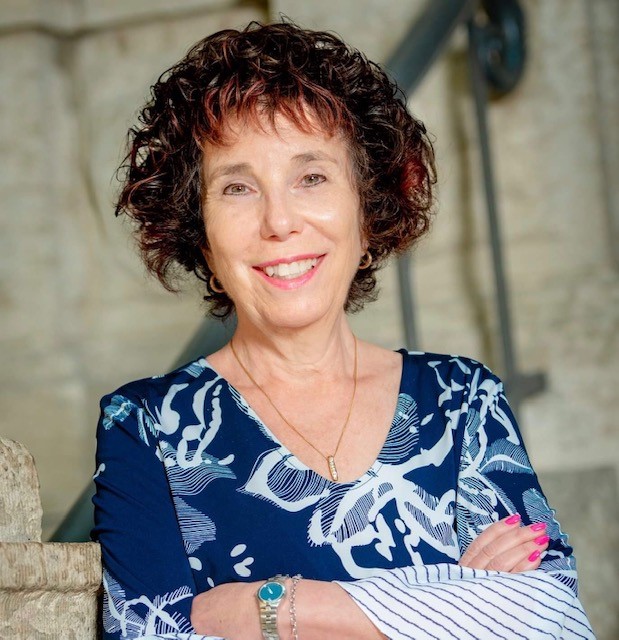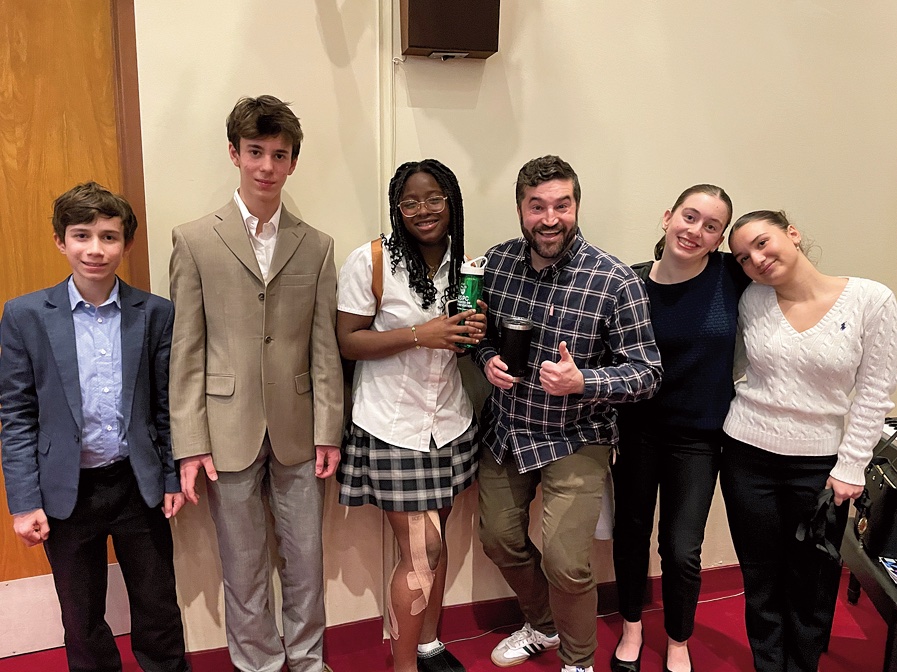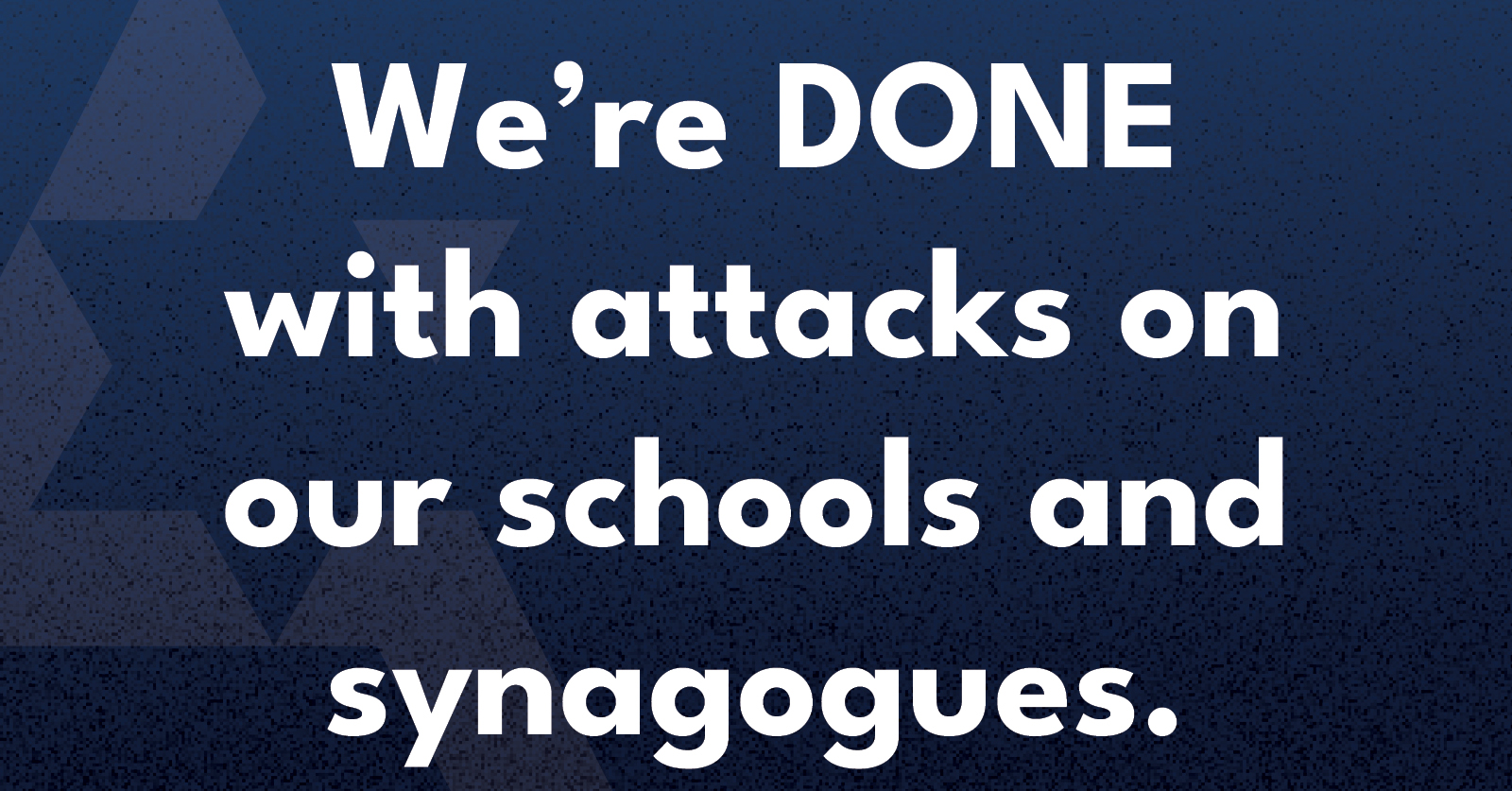Local News
Winnipeg congregations report largest attendances since 2019 for high holidays

By MYRON LOVE It was a frailiche Yom Tov this year. From all reports, there seems to have been a real joy for people able to once again attend services without having to deal the Covid restrictions of past years.
The final numbers are in and they tell the story. Overall, Yom Tov attendance was almost back to where it was pre-Covid restrictions. Lets start with the Shaarey Zedek, our community’s oldest and largest congregation.
Dr. Rena Secter Elbaze , the Shaarey Zedek’s executive director, reports that close to 700 worshippers attended the main service, 268 more were at the family service and just over 340 followed online. In comparison, about 200 were in attendance in person last year and that number included attendance at both services.
For this year, we decided to have only one service,” Secter Elbaze says. “It was wonderful having everyone together again. Some people were really emotional about being able to come together again.”
As noted in my pre-High Holidays report, this was the second year that the Shaarey Zedek held Rosh Hashanah and Yom Kippur services in the gym of the Rady JCC. Regular Shabbas services have continued to be held in the Berney Theatre, with weekday services at Temple Shalom – while their long term, spiritual home is being updated and expanded. Elbaze had noted that “in an effort to show our members that we appreciate their patience and understanding during this period of construction, we offered all of our members free seating for Yom Tov for those who wanted to attend services in person, as well as congregants viewing the services on-line.”
Non-members, she added, were able to[purchase their seats and be eligible for free seating if they participated in the daily minyanim or volunteered their time to help with Shabbat minyanim.
A further incentive was the return of popular Rabbi Alan Green to join Rabbi Anibal Mass in leading the main service. Rabbi Mass also led the family service – accompanied by Grant Park High School Grade 12 student Noah Trachtenberg – in the Asper Campus Multipurpose room.
The Yom Tov experience was further enhanced for Shaarey Zedek worshippers by the participation of the popular Quartet and the 20-voice Ruach Folk Choir.
“We were very pleased with how everything turned out,” Elbaze says. “This was the best Yom Tov ever.
“And we are really looking forward to being back in our own building in time for next Yom Tov.”
The members of Congregation Etz Chayim are also looking forward to davening in their new building. Next month, the congregation is scheduled to leave their current 70-year-old location in north Winnipeg and move into the new Etz Chayim building.
Etz Chayim Congregation Executive Director Jonathan Buchwald wrote in an email: “The general feedback from congregants was that they really enjoyed services this year. It was noted, however, that there were some bittersweet feelings, as these were the final High Holy Day Services in the Matheson Avenue building. We are looking forward to holding services next year in our new home at 1155 Wilkes Avenue, formerly the Shriners headquarters, near the IKEA store in south Winnipeg.“
Buchwald reports that 500 tickets were sold in person for Rosh Hashanah and Yom Kippur, with another 70 screens watching on-line – which grew to 90 for Kol Nidre. Almost 200 people attended Ne’ilah services. He adds that about 60 people attended a special service in the junior auditorium, led by Deborah Spigelman and Nina Eilberg, which was designed for families of all ages,while 50 children of all ages attended the junior service.
“On the first day of Rosh Hashanah and on Kol Nidre,” he says, “we held a unique program designed for teens in grades 9 to 12 led by Halley Ritter,” Buchwald added.
“One of the highlights of our services occurred during Kol Nidre,” he noted. “It involved the removal of all our Sifrei Torah which were then held by various congregants for each of the three recitals of the Kol Nidre prayer. For the first recital, the Sifrei Torah were held exclusively by teenagers and young adults.”
Services were led by Rabbi Kliel Rose and Cantor Tracy Kasner – with Kelly Robinson leading the High Holy Day Choir.
The third largest gathering for the High Holidays this year was Rabbi Matthew Leibl’s brand new “Services on the River: A modern High Holidays” which were held at the scenic Gates on Roblin. “I was very pleased with the attendance,” says the rabbi, who has been in demand for weddings, funerals and other community events since he left the Shaarey Zedek four years ago. “I wasn’t sure what to expect,” added Rabbi Leibl.
He reports that 250 signed up for his Yom Tov services. “We had a good mix of ages. We had families, couples, singles, even multigeneration families.”
In our earlier pre-Yom Tov report, Rabbi Leibl had observed that he had a lot of people asking him what he was going to do for Yom Tov. “I perceived that there was a need for another alternative for High Holiday services,” he noted.
Services on the River: A modern High Holidays” were scheduled for the second day of Rosh Hashanah, Kol Nidre and Yom Kippur morning. “Because the shofar is not traditionally blown on Shabbat, we decided to celebrate Rosh Hashanah on the second day instead to be able to have the shofar in our service,” Rabbi Leibl pointed out in explaining why he didn’t offer services for the first day of Rosh Hashanah.
The three services were each 90 minutes in length. “My services were designed to offer moments of reflection and introspection, beautiful live music, and a celebration of the Jewish New Year, all against the pastoral backdrop of the Assiniboine River, which was also our site for Tashlich on Rosh Hashanah,” Rabbi Leibl noted.
“With the river right outside the door, there was a strong sense of serenity accompanying Tashlich,” he added.
Rabbi Leibl described “Services on the River: A modern High Holidays” as “a real team effort,” which he led in collaboration with the husband and wife cantorial team of Justin Odwak and Sarah Sommer.
Most likely, readers can look forward to a reprise of “Services on the River: A modern High Holidays” next year.
Still with the South End, both Ruth Livingston and Jack Craven, presidents respectively of Reform Congregation Temple Shalom and the Orthodox Adas Yeshurun Herzlia report good turnouts for the High Holidays this year – with new families at both their services. The Lubavitch Centre’s Rabbi Avroham Altein also reports some new families at the services this year.
Back in the North End, Rob Waldman, the president of the egalitarian Chevra Mishnayes congregation in Garden City, noted in an earlier interview that the board was not expecting much change from last year. Last year’s attendance was 90 – exceeding expectations. This year’s services, led again by Al Benarroch, also attracted about 90 people.
The venerable House of Ashkenazie, the last of our community’s older-style Orthodox congregations, was the only shul to report a bit of a decline in attendance from last year – when about 50 people came for the first day of Rosh Hashanah and over 40 for Kol Nidre. – numbers which were the best in some years.
One new option this year for frum members of our community living in the North End was the reborn Chavurat Tefila – on the corner of Hartford and McGregor – which has reopened – after being closed for three years – as the North End Orthodox Minyan. The new congregation began regular Shabbat services at the end of July. Yom Tov services attracted about 40 men and women, with Rosh Hashanah services led by Avi Posen – who came in from Israel – and Yom Kippur services by Cantor Natanel “Naty” Schlossberg from Brooklyn .
Finally, there was one more option for those seeking to attend a High Holiday service. After a two year absence, Camp Massad resumed its innovative Rosh Hashanah service last year. Daniel Sprintz, the camp’s executive director, was pleased to announce that Massad was again hosting its usual Rosh Hashanah program on the second day.
Local News
Cheryl Hirsch Katz, Jewish Child and Family Service’s longest serving staffer, set to retire at end of the month

By MYRON LOVE “I loved working at Jewish Child and Family Service,” says Cheryl Hirsh Katz, who is due to retire at the end of June. “I have always appreciated the warm and welcoming atmosphere here. I feel that the people working here are my extended family. I am going to miss my colleagues”.
“I have derived great satisfaction over the years to have been able to help many people in our community of all ages through my work at JCFS,” she continues.
After 44 years at the agency, Katz, the longest-serving member of the staff, was given an appreciative send-off at the JCFS’s recent (June 23) Annual General Meeting at the Shaarey Zedek Synagogue.
The daughter of Art and Bess Hirsh, Cheryl grew up in Garden City. She attended Peretz School, then Jefferson Junior High and Garden City Collegiate. She joined the staff of JCFS in 1981, shortly after receiving her Bachelor of Social Work degree.
She earned an MSW in 1990.
“I chose to become a social worker,” she recalls, “because I always wanted to be able to help people.”
Katz was originally hired by JCFS to work with newcomers. After a couple of years, she was given responsibility for looking after the needs of older adults.
“I really enjoyed working in older adult services,” she says. “That is where I spent the bulk of my time at JCFS.”
After ten years as a case worker, she was promoted to a supervisory role. Later, she was also given responsibility for mental health and addictions programming and settlement services, while keeping the older adult files under her purview.
“As a supervisor, I wasn’t directly involved with individual clients,” she points out. “I was more involved with programming. Among the programs for seniors we organized were – for example – sessions on elder abuse, digital storytelling and memory loss.”
She notes that one of the trends she has seen over the last 44 years is that people are living longer and living in their homes longer. A lot more of our clients are living well into their 90s,” she observes. “We have had to continually expand our staff and the services we provide in order to accommodate the growing demands of an aging population.”
She also spoke of the mental health needs of seniors and aging Holocaust survivors.
She says that she has mixed feelings about leaving JCFS. “After so many years working full time, I am going to have to create a new routine,” she comments.
She notes that, now that she is retired, she will have more time to spend with her parents – who are in their 90s.
And then, there are the two dogs to look after. “I will have time now to try new activities,” she says. “ I might learn to play mah-jong.”
She speaks about maybe doing some traveling – although her husband, Murray, is still working full time.
(She and Murray have one daughter, Farah.)
“Retirement may also include some volunteering,” she adds.
It is quite likely, she will be continuing her association with JCFS but in a volunteer capacity.
Local News
Gray Academy students shine in provincial, national debating competitions

By MYRON LOVE It has been another good year for Gray Academy’s high school students who participated in provincial and national debating competitions. The best results were recorded by Grade 9 student Noa Mednikov, who finished fourth overall nationally, fourth in interpretive reading, and fifth in persuasive speaking at the junior National Public Speaking Championship in early May in Vancouver.
Last October, in the Junior Provincial British Parliamentary Championship – which was held at St. John’s-Ravenscourt – Noa and her partner, Raya Braunstein, finished third as a team while Raya placed third in individual debating.
Their fellow Grade 9 student Maxim Moscalenkov tied for first in persuasive speaking in Vancouver, while the Gray Academy team of Gabe Tapper and Aaron Koplovich finished fifth. Aaron also finished fifth in his individual debate.
Earlier, in March, Maxim finished fifth in the Provincial Juniors debating competition, which was held at Balmoral Hall He and his debate partner, Nate Shenkarow, finished seventh among the teams entered. Last November, he and partner, Ethan Tenenbein, finished seventh in the Junior Prepared Tournament – just behind the Gray Academy team of Nate Shenkarow and Jack Kay.
At the senior high level in that competition, the team of Jacob Tenenbein and Jonah Novoseller finished fourth and Jacob was recognized as fifth best in an individual capacity. Jonah and Jacob also paired up to win the Asper Cup, which was held at their home school.
Jacob represented Manitoba at the Junior National Speech Championship in Vancouver in May and, last October, he and Grade 12 Gray Academy students Julie Krozkin and Daniel Bokser represented Canada at an international debating tournament in Bermuda.
Gray Academy’s debating program was introduced by Linda Martin in 2003. She also led the debating teams at Balmoral Hall. In 2011, Martin was succeeded by Gray Academy high school English teacher Andrew Kaplan.
“Andrew has done a wonderful job with the debating program” says Martin, who has a debating trophy at Gray Academy named in her honour, as well as a provincial trophy for best individual junior debater. “Over the years, Gray Academy students have done very well in many local, national and international competitions,” she adds.
About three weeks ago, this writer had the opportunity to sit down with Andrew Kaplan and six of the school’s top debaters while they discussed the benefits of learning how to debate. According to Noah Strauss – who competed in the Junior Provincials at Balmoral Hall in March, public speaking leaves him with a feeling of accomplishment.
“It’s a good skill set to have,” he observes. “It builds confidence.”
“A benefit of being able to debate is that you learn how to convince people that you know what you are talking about,” adds Maxim Moscolenkov.
Raya Braunstein notes that being able to debate is a skill that she expects to be helpful in many university courses which she may choose to take.
As Andrew Kaplan notes, the ability to express yourself has a great impact in whatever career you choose to pursue.
He points out that debating is compulsory at Gray Academy for all Grade 7 and 8 students – and students can continue debating as an option in the higher grades
Of course, competitive debating is not for everyone. For those students who opt to take that path, the journey begins with internal school debate competition – with the top debating teams and individuals qualifying for local tournaments and – potentially – beyond.
Andrew Kaplan reports that a small number of high schools in Winnipeg and southern Manitoba have active debating programs – including St. Johns Ravenscourt, St. Paul’s High School, St. Mary’s Academy, Garden City and Maples Collegiates in the Seven Oaks School Division, St. Maurice (a Catholic School), as well as Morden Collegiate and Dasmesh, a Sikh private school.
Kaplan expresses his appreciation to the Asper Foundation and an endowment spearheaded by the Kives Family for providing funding for the Gray Academy debating program – as well as the Andrew Slough Foundation – which was established by his friends in memory of the outstanding former Ravenscourt student debater and lawyer who passed away suddenly two years ago at the still young age of 38.
I am confident that our Jewish community can look forward to the continued success of Gray Academy’s star debaters and to the continual emergence of future stars as the times goes by.
Local News
Antisemitism has crept into grade school in Canada

Antisemitism in Canada has moved beyond protests and politics; it is now entering classrooms and altering how Jewish children see themselves functioning within them.
A a university student I have observed the experience of my younger brother in grade eight as a Jewish student. Over the past few months, his school has been at the center of several deeply troubling incidents that have made him feel unsafe in our parks, community, and even his school. Swastikas were drawn around the community, in parks and ponds. Additionally, an older man, who claims to be a pro-Palestinian influencer, stood outside his predominantly Jewish school wearing a keffiyeh, filming a video which then circulated between students on TikTok.
This same man later showed up to our local Jewish community center in keffiyeh to allegedly watch his son play basketball where my brother and many of his classmates go for their lessons, basketball games, and Jewish events. These moments made him and his peers feel watched and targeted just for being Jewish. Local political representatives condemned the incidents and raised awareness about antisemitism, but the fear among students didn’t go away. The feeling of being targeted for simply existing has been taught to my brother, something my parents had tried their hardest to escape from.
Most recently, my brother was chosen to represent his school at a regional science fair. When one of the judges arrived wearing a keffiyeh, he froze. For many, including my brother after the incidents he has faced, the keffiyeh represents a political message. But even more so for my younger brother, it is tied to the fear and intimidation he had already experienced. He felt nervous, distracted, and unsure of how to act.
This is not about silencing political expression. It is about a child who came to share his ideas and left feeling uncertain and afraid. It is about the atmosphere forming in Canadian schools, where Jewish students are being made to feel targeted and unwelcome.
His school made an effort to address the incidents, but the impact is lasting. Posts on social media, much can be very vague at times about inclusion cannot fully undo the feeling of being singled out. A kind word from a teacher does not erase the fear that builds when threats are left unspoken but deeply felt.
I am writing this as a sister who watched her younger brother lose a moment that should have been filled with confidence and pride. He deserved to feel safe. So do all Jewish students in this country.
Moving forward, schools must take concrete steps to protect all students. Antisemitism cannot only be addressed when it becomes violent or overt. It must also be recognized when it appears as intimidation, symbolic targeting, or political messaging that creates fear among students. Children should never have to question whether they are safe in their own classrooms or community spaces.
Events that are meant to support and celebrate students must remain focused on them. Individuals who feel the need to bring political symbols or messages into school grounds or children’s events should not be welcomed in those spaces. Schools must make it clear that their environments exist to support learning, safety, and inclusion, not to host agendas that can intimidate or isolate students.
Administrators and educators must develop clear guidelines for identifying and responding to antisemitic behavior in all its forms. This includes strengthening security measures, offering ongoing staff training, and engaging directly with Jewish families to understand their concerns. Inclusion is not a one-time statement. It is a responsibility that must be reflected in everyday decisions and actions. No child should ever feel unsafe or unwelcome because of their identity.
The author is a Campus Media Fellow with HonestReporting Canada and Allied Voices for Israel who lives in Toronto.
